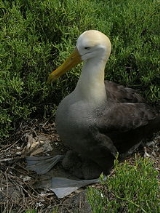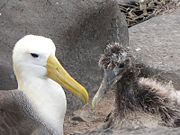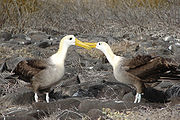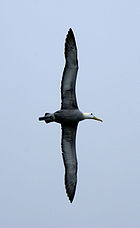
Waved Albatross
Encyclopedia
The Waved Albatross, Phoebastria irrorata - also known as Galapagos Albatross - is the only member of the Diomedeidae family located in the tropics. When they forage, the Waved Albatross follow straight paths to a single site off the coast of Peru
, about 1000 km (621.4 mi) distant to the east. During the non-breeding season, these birds reside primarily in the areas of the Ecuador
and Peru
vian coasts.
order, along with Shearwater
s, Fulmar
s, Storm-petrel
s, and Diving-petrels. They share certain identifying features. First, they have nasal passages that attach to the upper bill called naricorns, although the nostrils of the Albatross are on the sides of the bill. The bills of Procellariiformes are also unique in that they are split into between 7 and 9 horny plates. Finally, they produce a stomach oil made up of wax ester
s and triglycerides that is stored in the proventriculus
. This is used against predators as well as an energy rich food source for chicks and for the adults during their long flights. They also have a salt gland that is situated above the nasal passage and helps desalinate their bodies, due to the high amount of ocean water that they imbibe. It excretes a high saline solution from their nose.
es, measuring about 86 to 90 cm (33.9 to 35.4 in) long, weighing in at 3.4 kg (7.5 lb), and having a wingspan 2.25m or 7.4 ft. They are distinctive for their yellowish-cream neck and head, which contrasts with their mostly brownish bodies. Even more distinctive is the very long, bright yellow bill, which looks disproportionately large in comparison to the relatively small head and long, slender neck. They also have chestnut brown upper parts and underparts, except for the breast, with fine barring, a little coarser on the rump. They have brown upper-wings, back, and tail, along with a whitish breast and underwings. Their axillaries
are brown. Finally they have blue feet. Juveniles are similar to adults except for more white on their head. Chicks have brown fluffy feathers. The lifespan of this species may reach 40 to 45 years.
in the Galápagos archipelago
; however, there have been sightings of non-breeders and therefore possible small numbers, around 10 to 20, of breeders on Genovesa Island
and Isla de la Plata
. During non-breeding season they will shift to the east and southeast to the continental shelf
region off the coast of Peru
and Ecuador
.
, squid
, and crustacean
s. But they have also been observed to scavenge for other food sources, including the regurgitated food of other birds. When foraging the Waved Albatross finds points in the ocean where prey will be more surfaced; this is the most effective way for the albatross to get its food. The Waved Albatrosses will forage 10 to 100 km (6.2 to 62.1 mi) away from the place where the chicks are nesting to get food for them.

 The nests are built on areas of lava with boulders and sparse vegetation, or thick brush. The courtship of the Waved Albatross is a very elusive and spectacular sight to see. It includes: rapid bill circling and bowing, beak clacking, and an upraised bill to make a whoo hoo sound. The eggs are laid between April and June and incubated for two months after that. When the eggs hatch, the chicks stay together in small nurseries while the parents go out to the sea for hunting. When the parents return, they may feed the chicks up to 2 kg (4.4 lb) of oil. The young reach adult size by December and leave the colony by January. The partners remain mates until one of the partners dies.
The nests are built on areas of lava with boulders and sparse vegetation, or thick brush. The courtship of the Waved Albatross is a very elusive and spectacular sight to see. It includes: rapid bill circling and bowing, beak clacking, and an upraised bill to make a whoo hoo sound. The eggs are laid between April and June and incubated for two months after that. When the eggs hatch, the chicks stay together in small nurseries while the parents go out to the sea for hunting. When the parents return, they may feed the chicks up to 2 kg (4.4 lb) of oil. The young reach adult size by December and leave the colony by January. The partners remain mates until one of the partners dies.
 Waved Albatross are spectacular flyers, perhaps even the most famous. They can fly for hours without stalling and they do this by dynamic soaring. The wind speed near the surface of the sea is much lower than about 50 ft (15.2 m) in the air. The waved albatross uses this to its advantage by gliding at speed into the wind. As the Waved Albatross glides higher it loses most of its ground speed because it is gliding into a wind of a higher speed. However, its air speed does not fall, enabling it to glide continuously. However, Waved Albatrosses do have difficulty taking off and landing due to their huge wings and slender bodies. To make it easier they sometimes take off on cliffs that are more inland and not next to the coast. The problem is when they come in to land they have a high stalling speed, and when they take off it's hard to beat their massive wings.
Waved Albatross are spectacular flyers, perhaps even the most famous. They can fly for hours without stalling and they do this by dynamic soaring. The wind speed near the surface of the sea is much lower than about 50 ft (15.2 m) in the air. The waved albatross uses this to its advantage by gliding at speed into the wind. As the Waved Albatross glides higher it loses most of its ground speed because it is gliding into a wind of a higher speed. However, its air speed does not fall, enabling it to glide continuously. However, Waved Albatrosses do have difficulty taking off and landing due to their huge wings and slender bodies. To make it easier they sometimes take off on cliffs that are more inland and not next to the coast. The problem is when they come in to land they have a high stalling speed, and when they take off it's hard to beat their massive wings.
The population of Waved Albatrosses on the Galápagos is protected by national park
personnel, and the island is also categorized as a World Heritage Site
. But limited range, bycatch
by long-line fishing
, disturbance via tourism, disease, and the effects of illegal fishing in the nearby waters place them in considerable jeopardy. Especially long-line fishing seems to be making a severe impact on the species, which was uplisted to Vulnerable from Near Threatened by the IUCN in 2000. Despite some 34,700 adult birds still occurring in 2001, their numbers have apparently started to decrease at an unknown rate more recently, probably due to longline fishing which also upsets the sex ratio
(males being killed more frequently). As the current situation makes the population highly vulnerable to a catastrophic collapse to extinction
, it was uplisted to Endangered status in the 2007 IUCN Red List
.
The population of 34,700 adult birds was based on a 2001 estimate; however in 1970 and 1971 there were an estimated 24,000, and 1994 saw between 31,200 and 36,400. This species has an occurrence range of 1750000 km² (675,678.8 sq mi), and a breeding range of 9 km² (3.5 sq mi).
Peru
Peru , officially the Republic of Peru , is a country in western South America. It is bordered on the north by Ecuador and Colombia, on the east by Brazil, on the southeast by Bolivia, on the south by Chile, and on the west by the Pacific Ocean....
, about 1000 km (621.4 mi) distant to the east. During the non-breeding season, these birds reside primarily in the areas of the Ecuador
Ecuador
Ecuador , officially the Republic of Ecuador is a representative democratic republic in South America, bordered by Colombia on the north, Peru on the east and south, and by the Pacific Ocean to the west. It is one of only two countries in South America, along with Chile, that do not have a border...
and Peru
Peru
Peru , officially the Republic of Peru , is a country in western South America. It is bordered on the north by Ecuador and Colombia, on the east by Brazil, on the southeast by Bolivia, on the south by Chile, and on the west by the Pacific Ocean....
vian coasts.
Taxonomy
Waved Albatrosses are a type of Albatross that belong to Diomedeidae family and come from the ProcellariiformesProcellariiformes
Procellariiformes is an order of seabirds that comprises four families: the albatrosses, petrels and shearwaters, storm petrels, and diving petrels...
order, along with Shearwater
Shearwater
Shearwaters are medium-sized long-winged seabirds. There are more than 30 species of shearwaters, a few larger ones in the genus Calonectris and many smaller species in the genus Puffinus...
s, Fulmar
Fulmar
Fulmars are seabirds of the family Procellariidae. The family consists of two extant species and two that are extinct.-Taxonomy:As members of Procellaridae and then the order Procellariiformes, they share certain traits. First, they have nasal passages that attach to the upper bill called...
s, Storm-petrel
Storm-petrel
Storm petrels are seabirds in the family Hydrobatidae, part of the order Procellariiformes. These smallest of seabirds feed on planktonic crustaceans and small fish picked from the surface, typically while hovering. The flight is fluttering and sometimes bat-like.Storm petrels have a cosmopolitan...
s, and Diving-petrels. They share certain identifying features. First, they have nasal passages that attach to the upper bill called naricorns, although the nostrils of the Albatross are on the sides of the bill. The bills of Procellariiformes are also unique in that they are split into between 7 and 9 horny plates. Finally, they produce a stomach oil made up of wax ester
Wax ester
An ester of a fatty acid and a long-chain alcohol. These oils have similar properties as triglycerides, but are indigestible. They are found in some fish such as orange roughy, oilfish, escolar, black oreo, smooth oreo and other deep water fish. They are also present in marine copepods. Wax...
s and triglycerides that is stored in the proventriculus
Proventriculus
The proventriculus is part of the digestive system of birds, invertebrates and insects.-Birds:The proventriculus is a standard part of avian anatomy...
. This is used against predators as well as an energy rich food source for chicks and for the adults during their long flights. They also have a salt gland that is situated above the nasal passage and helps desalinate their bodies, due to the high amount of ocean water that they imbibe. It excretes a high saline solution from their nose.
Etymology
The Waved Albatross derives its name from the wave-like pattern of its feathers on the adult birds.Description
These are medium-sized albatrossAlbatross
Albatrosses, of the biological family Diomedeidae, are large seabirds allied to the procellariids, storm-petrels and diving-petrels in the order Procellariiformes . They range widely in the Southern Ocean and the North Pacific...
es, measuring about 86 to 90 cm (33.9 to 35.4 in) long, weighing in at 3.4 kg (7.5 lb), and having a wingspan 2.25m or 7.4 ft. They are distinctive for their yellowish-cream neck and head, which contrasts with their mostly brownish bodies. Even more distinctive is the very long, bright yellow bill, which looks disproportionately large in comparison to the relatively small head and long, slender neck. They also have chestnut brown upper parts and underparts, except for the breast, with fine barring, a little coarser on the rump. They have brown upper-wings, back, and tail, along with a whitish breast and underwings. Their axillaries
Axillary
Axillary means "related to the axilla "."Axillary" may refer to:* Axillary artery* Axillary vein* Axillary nerve* Axillary bud...
are brown. Finally they have blue feet. Juveniles are similar to adults except for more white on their head. Chicks have brown fluffy feathers. The lifespan of this species may reach 40 to 45 years.
Range
The Waved Albatross breeds primarily on Española IslandEspañola Island
Española Island is part of the Galápagos Islands. The English named it Hood Island after Viscount Samuel Hood. It is located in the extreme southeast of the archipelago and is considered, along with Santa Fe, one of the oldest, at approximately four million years...
in the Galápagos archipelago
Galápagos Islands
The Galápagos Islands are an archipelago of volcanic islands distributed around the equator in the Pacific Ocean, west of continental Ecuador, of which they are a part.The Galápagos Islands and its surrounding waters form an Ecuadorian province, a national park, and a...
; however, there have been sightings of non-breeders and therefore possible small numbers, around 10 to 20, of breeders on Genovesa Island
Genovesa Island
Genovesa Island is a shield volcano in the Galápagos Islands in the eastern Pacific Ocean. The island occupies about , and its maximum elevation is . The horse-shoe shaped island has a volcanic caldera whose wall has collapsed, forming the Great Darwin Bay, surrounded by cliffs...
and Isla de la Plata
Isla de la Plata
Isla de la Plata is a small island off the coast of Manabí, Ecuador, and is part of Parque Nacional Machalilla. It can be reached by boat from the city of Puerto López....
. During non-breeding season they will shift to the east and southeast to the continental shelf
Continental shelf
The continental shelf is the extended perimeter of each continent and associated coastal plain. Much of the shelf was exposed during glacial periods, but is now submerged under relatively shallow seas and gulfs, and was similarly submerged during other interglacial periods. The continental margin,...
region off the coast of Peru
Peru
Peru , officially the Republic of Peru , is a country in western South America. It is bordered on the north by Ecuador and Colombia, on the east by Brazil, on the southeast by Bolivia, on the south by Chile, and on the west by the Pacific Ocean....
and Ecuador
Ecuador
Ecuador , officially the Republic of Ecuador is a representative democratic republic in South America, bordered by Colombia on the north, Peru on the east and south, and by the Pacific Ocean to the west. It is one of only two countries in South America, along with Chile, that do not have a border...
.
Feeding
The primary food sources of the Waved Albatross are fishFish
Fish are a paraphyletic group of organisms that consist of all gill-bearing aquatic vertebrate animals that lack limbs with digits. Included in this definition are the living hagfish, lampreys, and cartilaginous and bony fish, as well as various extinct related groups...
, squid
Squid
Squid are cephalopods of the order Teuthida, which comprises around 300 species. Like all other cephalopods, squid have a distinct head, bilateral symmetry, a mantle, and arms. Squid, like cuttlefish, have eight arms arranged in pairs and two, usually longer, tentacles...
, and crustacean
Crustacean
Crustaceans form a very large group of arthropods, usually treated as a subphylum, which includes such familiar animals as crabs, lobsters, crayfish, shrimp, krill and barnacles. The 50,000 described species range in size from Stygotantulus stocki at , to the Japanese spider crab with a leg span...
s. But they have also been observed to scavenge for other food sources, including the regurgitated food of other birds. When foraging the Waved Albatross finds points in the ocean where prey will be more surfaced; this is the most effective way for the albatross to get its food. The Waved Albatrosses will forage 10 to 100 km (6.2 to 62.1 mi) away from the place where the chicks are nesting to get food for them.
Breeding


Flight

Conservation
| Breeding Location | Breeding Pair | Trend |
| Isla de la Plata Isla de la Plata Isla de la Plata is a small island off the coast of Manabí, Ecuador, and is part of Parque Nacional Machalilla. It can be reached by boat from the city of Puerto López.... |
20 to 40 | unknown |
| Galapagos Islands Galápagos Islands The Galápagos Islands are an archipelago of volcanic islands distributed around the equator in the Pacific Ocean, west of continental Ecuador, of which they are a part.The Galápagos Islands and its surrounding waters form an Ecuadorian province, a national park, and a... |
34,660 | 1 to 19% decline over 84 years |
| Total | 34,700 | 1 to 19% decline over 84 years |
The population of Waved Albatrosses on the Galápagos is protected by national park
National park
A national park is a reserve of natural, semi-natural, or developed land that a sovereign state declares or owns. Although individual nations designate their own national parks differently A national park is a reserve of natural, semi-natural, or developed land that a sovereign state declares or...
personnel, and the island is also categorized as a World Heritage Site
World Heritage Site
A UNESCO World Heritage Site is a place that is listed by the UNESCO as of special cultural or physical significance...
. But limited range, bycatch
Bycatch
The term “bycatch” is usually used for fish caught unintentionally in a fishery while intending to catch other fish. It may however also indicate untargeted catch in other forms of animal harvesting or collecting...
by long-line fishing
Long-line fishing
Longline fishing is a commercial fishing technique. It uses a long line, called the main line, with baited hooks attached at intervals by means of branch lines called "snoods". A snood is a short length of line, attached to the main line using a clip or swivel, with the hook at the other end....
, disturbance via tourism, disease, and the effects of illegal fishing in the nearby waters place them in considerable jeopardy. Especially long-line fishing seems to be making a severe impact on the species, which was uplisted to Vulnerable from Near Threatened by the IUCN in 2000. Despite some 34,700 adult birds still occurring in 2001, their numbers have apparently started to decrease at an unknown rate more recently, probably due to longline fishing which also upsets the sex ratio
Sex ratio
Sex ratio is the ratio of males to females in a population. The primary sex ratio is the ratio at the time of conception, secondary sex ratio is the ratio at time of birth, and tertiary sex ratio is the ratio of mature organisms....
(males being killed more frequently). As the current situation makes the population highly vulnerable to a catastrophic collapse to extinction
Extinction
In biology and ecology, extinction is the end of an organism or of a group of organisms , normally a species. The moment of extinction is generally considered to be the death of the last individual of the species, although the capacity to breed and recover may have been lost before this point...
, it was uplisted to Endangered status in the 2007 IUCN Red List
IUCN Red List
The IUCN Red List of Threatened Species , founded in 1963, is the world's most comprehensive inventory of the global conservation status of biological species. The International Union for Conservation of Nature is the world's main authority on the conservation status of species...
.
The population of 34,700 adult birds was based on a 2001 estimate; however in 1970 and 1971 there were an estimated 24,000, and 1994 saw between 31,200 and 36,400. This species has an occurrence range of 1750000 km² (675,678.8 sq mi), and a breeding range of 9 km² (3.5 sq mi).

